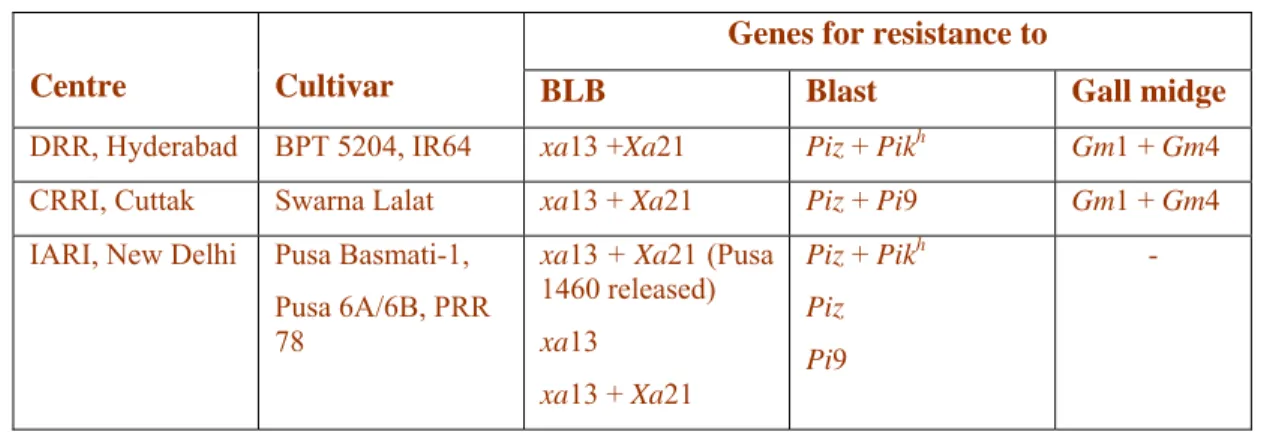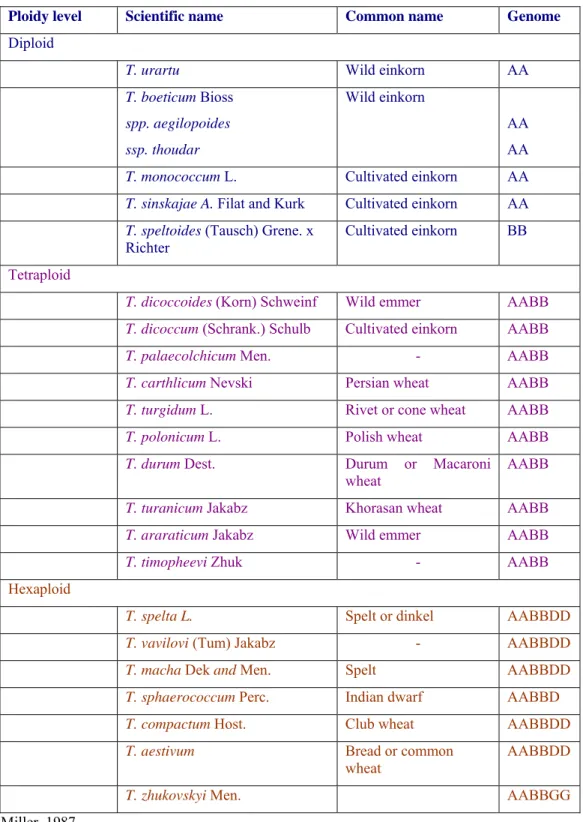Rice belongs to the genus Oryza of the tribe Oryzae under the subfamily Oryzoidae in the grass family Graminae (Poaceae). The amphidiploid cross between two variants (2n=12) resulted in the cultivated rice and its wild ancestors with 2n=24 chromosomes. Genetic improvements in rice and the development of modern rice varieties, along with improved cultivation practices, are responsible for the impressive growth in production.
Among the different breeding strategies, emphasis is placed on pure line selection in the native breeds well adapted to a given stress environment as a short-term approach.

Grain yield: The main objective is to create new genotypes improved in features that contribute to greater yield potential and improved product quality. Yield potential in wheat
Grain yield: The main objective is to create new genotypes with improved properties that contribute to greater yield potential and improved product quality.
Breeding for disease and pest resistance: The development of cultivars of wheat with resistance to destructive disease pathogens like rust, karnal bunt, leaf blotch, smuts, powdery
Efforts to improve lysine as well as high protein content are needed to improve the nutritional quality of wheat. Being a self-pollinated crop, the basic methods of wheat improvement include pure line, pedigree, bulk and backcross methods. During the period of yield plating, IB/IR translocations played a significant role in breaking the yield boundaries, leading to an increase in wheat yields. The more recent genotypes such as PBW 343, UP 2338 and WH 542 are derived from crosses with Veery genotypes, but still carry IB/IR translocation and have higher yield potential.
Finally, the combination of resistance to all three rusts resulted in the development of the wheat variety NP 809. The main factor controlling grain hardness is a single Ha site on wheat chromosome 5D that encodes a 15 kDa protein called Friabilin. The genes encoding glutenin and gliadins are located on chromosomes group 1 and group 6 of wheat.
New biotechnological techniques have opened up possibilities for investigating the fundamental and biochemical aspects of individual protein subunits and of other molecules that contribute to the end-use quality of wheat. CIMMYT (International Maize and Wheat Improvement Center), Mexico, is leading Harvest Plus' research efforts in collaboration with national agricultural research and extension systems for the biofortification of wheat for high iron and zinc content using conventional and molecular breeding approaches. To meet the ever-increasing demand for wheat, which will reach 109 million tons by the year 2020, the current productivity level must be increased to 4.4 tons/ha.
Somaclonal variation: The variation observed in plants produced through tissue culture is known as somaclonal variation. Wheat has proved to be an excellent material for the induction
In vitro production of haploids: Haploids are important for studies on the induction of mutations and for the production of double haploid/homozygous plants. Somaclonal Variation: The variation observed in plants produced through tissue culture is known as somaclonal variation.
Molecular markers and wheat breeding: The development in molecular genetics in wheat have been relatively slow due to its ploidy level, the size and complexity of its genome, the very
The main maize growing states in India are Andhra Pradesh, Karnataka, Bihar, Himachal Pradesh, which account for about 30% of the maize area. These breeds adapted to different agro-climatic regions away from the center of origin. According to one hypothesis maize originated from a single domestication from basal branching teosinte sub sp.
These breeds are important to breeders' search for germplasm containing special characteristics for use in the breeding program. Maize is a monoecious cross-pollinated plant with persistent flowers borne in panicles and pistillate flowers on a cob. The main axis and branches of the tassel usually bear pairs, one sessile and the other pedicel.
Around the middle of the stem, one or two shoot buds develop into lateral shoots that bear the female inflorescence known as an ear. The bud of the ear consists of a tube which bears modified shell-like sheaths of leaves and the internodes of the throat are highly condensed. Since maize has a wide range of food and industrial uses, the breeding objective depends on various factors such as the target market end product, the farmer's perspective, the specific agro-climatic situation as well as production constraints and levels.
Yield improvement: The most important objective is to increase grain yield which is a quantitatively inherited complex trait and its expression is influenced by several yield
Each spikelet bears two florets each with a lemma, a palea, three stamens two lodicules and a rudimentary pistil. On the root shoot, pistillate spikelets are borne in pairs in longitudinal rows from base to tip. Maize is protandrous in nature in which pollen shedding begins before silk emergence, thus facilitating cross-pollination by wind-borne pollen grains.
Pollen shedding begins about 2 or 3 days after the tassel has fully emerged and continues for several days. Since maize is a C4 plant, the breeding goal should utilize the crop's inherent production potential.
Adaptability and stability: Development of varieties or hybrids with wide adaptability and stability is to ensure higher and stable returns to the farmers. Adaptability is also a complex
Yield improvement: The most important objective is to increase wheat yield, which is a complex quantitative inherited trait and its expression is influenced by several yields. The suitability of hybrids/varieties depends on the productivity of the soil as they respond more to fertility levels. In addition to superior yield performance, cultivars should have the inherent potential to perform well in a wide range of environments, particularly in areas where it is grown during seasons characterized by erratic rainfall, as well as in environments for which resistance/tolerance against stresses is very important. I.e.
The most serious diseases of maize in India are leaf blight (Drschlera turcica), leaf blight (D. maydis), post-flowering leaf blight (Drschlera turcica), leaf blight (D. maydis), flowering stem blight complex (Macrophomina phaseolina, Fusarium spp., Cephalsporium spp.), downy mildew (Perenosclerophthora soghi) and common rust (Puccinia sorghi). Similarly, insect pests like stem borers, cutworms, aphids, cutworms, jassids, cutworms, rootworms, leaf miners, etc. Understanding the genetic control of these diseases and insect pests and identifying sources of resistance to them is important to design an appropriate breeding strategy.
Methods are being developed to create artificial epiphytic conditions, to facilitate the selection of resistant genotypes and the inclusion of resistance genes in inbred lines and hybrids.
Breeding for quality: The maize kernel is composed of approximately 7% starch, 10%
Breeding methods should aim at exploiting heterozygosity in a desired direction and at large-scale exploitation of hybrid vigour. Introduction: Many of the introductions have been used directly as commercial cultivars in many countries including India, such as composite Laxmi and Suwan released in Bihar state and.
Introduction: Many of the introductions have been used directly as commercial cultivars in many countries including India such as composite Laxmi and Suwan released in Bihar state and
Population improvement: Population improvement aims at increasing the frequency of favourable alleles in the population and at the same time maintaining considerable genetic
Full relatives are created by crossing selected plants in pairs in the original population, and the crossed seeds are used for the progeny test as well as for the reconstitution of an improved new base population. Simple recurrent selection: In this method, several plants with the desired phenotype are selected and self-fertilized. In the following year, the progeny lines from the self-fertilized seeds of the selected plants and progeny are crossed in all possible combinations and an equal amount of seed from each cross is assembled to produce the next generation.
Recurrent selection is effective in increasing the frequency of desirable genes in the selected population. Recurrent selection for general combining ability (RSGCA): In the case of recurrent selection for gca, progeny for progeny testing are obtained by crossing the selected plants to a broad-based tester (an open-pollinated variety, a synthetic variety, or the segregating generations of double or multiple crosses). The self-treated seeds from the plants that produced superior test cross progeny (as identified in the second year) are planted in the progeny rows and crossed in all possible combinations.
This completes the original selection cycle and further repeated selections are carried out in the same manner. Recurrent Reciprocal Selection (RRS): It was proposed by Comstock, Robinson and Harvey in 1949 for improving two different populations in their ability to interbreed. Modifications of these methods are full-sib recurrent reciprocal selection as well as half-sib recurrent reciprocal selection.
Development of synthetic varieties: A synthetic variety is a variety produced by crossing in all combinations a number of inbred lines (with high gca that combine well with each other) and
The procedure is identical to that of GCA, except that in this one an inbred is used as a tester rather than an open pollinated variety. RSSCA helps to isolate from a population such lines that will combine well with a given inbred and is useful for exploiting heterosis due to non-additive replication. Two genetically broad-based populations (A and B), such that 'A' serves as a tester for B and 'B' serves as a tester for A.
This method is as efficient as RSGCA when additive gene action dominates and is as efficient as RSSCA when non-additive effects are very important.
Development of composite varieties: Composite varieties in maize are derived by mixing the seeds of several phenotypically outstanding lines and allowing open pollination among the mixed
Kaushambi) 2002 Central and eastern Uttar Pradesh, Bihar, West Bengal and parts of Assam 6 VL 804 2002 Hilly area of Himachal Pradesh, Uttarakhand, and Jammu & Kashmir 7 VL 829 2002 Western Himalayan regions of Jammu and Kashmir (except 8 Jammu and Kashmir DBW 14 2002 Eastern Uttar Pradesh, Bihar, West Bengal, Jharkhand, Orissa and Assam 9 HS 420 (Shivalik) 2002 Western Himalayan regions of Jammu and Kashmir (except Jammu and . Kathua distt.); Himachal Pradesh (except Una Valley) and Paonta Valley 12 HS 375 (Himgiri) 2003 High altitudes of the northern hill zone comprising Himachal Pradesh, Uttarakhand, Jammu and Kashmir regions.
14 एमपी 4010 2003 मध्य प्रदेश, छत्तीसगढ़, गुजरात, राजस्थान में कोटा और उदयपुर डिवीजन और उत्तर प्रदेश में झांसी डिवीजन। 16 वीएल 829 2003 जम्मू और कश्मीर में वेस्टलीज हिमालय-क्षेत्र (जम्मू और कठुआ जिला सहित); हिमाचल प्रदेश (पहले ऊना और पोंटा घाटी); 24 एचआई 1531 (हर्षिता) 2006 मध्य प्रदेश, छत्तीसगढ़, गुजरात, राजस्थान में कोटा और उदयपुर डिवीजन और उत्तर प्रदेश में झांसी डिवीजन।
3 डेक्कन 115 2003 पंजाब, उत्तर प्रदेश, बिहार, असम, उड़ीसा, पश्चिम बंगाली झारखंड 4 प्रताप कंपोजिट-4 2003 दिल्ली, हरियाणा, पंजाब, उत्तर प्रदेश, बिहार, असम, उड़ीसा झारखंड लिंडोर 5, एफएचहरखंड 51020 असम, उड़ीसा, झारखंड धे छत्तीसगढ़ 6 विवेक-15 2004 जम्मू-कश्मीर, हिमाचल प्रदेश, कोदरात उत्तराखंड धे पश्चिम बंगाली 7 विवेक 17 2004 दिल्ली, हरियाणा, पंजाब, आंध्र प्रदेश, महाराष्ट्र, कर्नाटक धे। 10 प्रताप मक्का-3 2004 राजस्थान, गुजरात और मध्य प्रदेश 11 विन पीली (मीठी मिश्री) 2004 हिमाचल प्रदेश, जम्मू और कश्मीर और उत्तरांचल 12 वीएल78 (बेबी कॉर्न) 2004 पूरे भारत में खरीफ और रबी मौसम के दौरान। 17 जेकेएमएच1701 2006 उत्तराखंड, हिमालय वेरिलिंडोर, हिमाचल प्रदेश, पश्चिम बंगाल, महाराष्ट्र, आंध्र प्रदेश, कर्नाटक और तमिलनाडु।
